Complete Planets in Evening, the Full Oak Moon Moves Across Opposition Mars, and Jupiter Shows Spots!
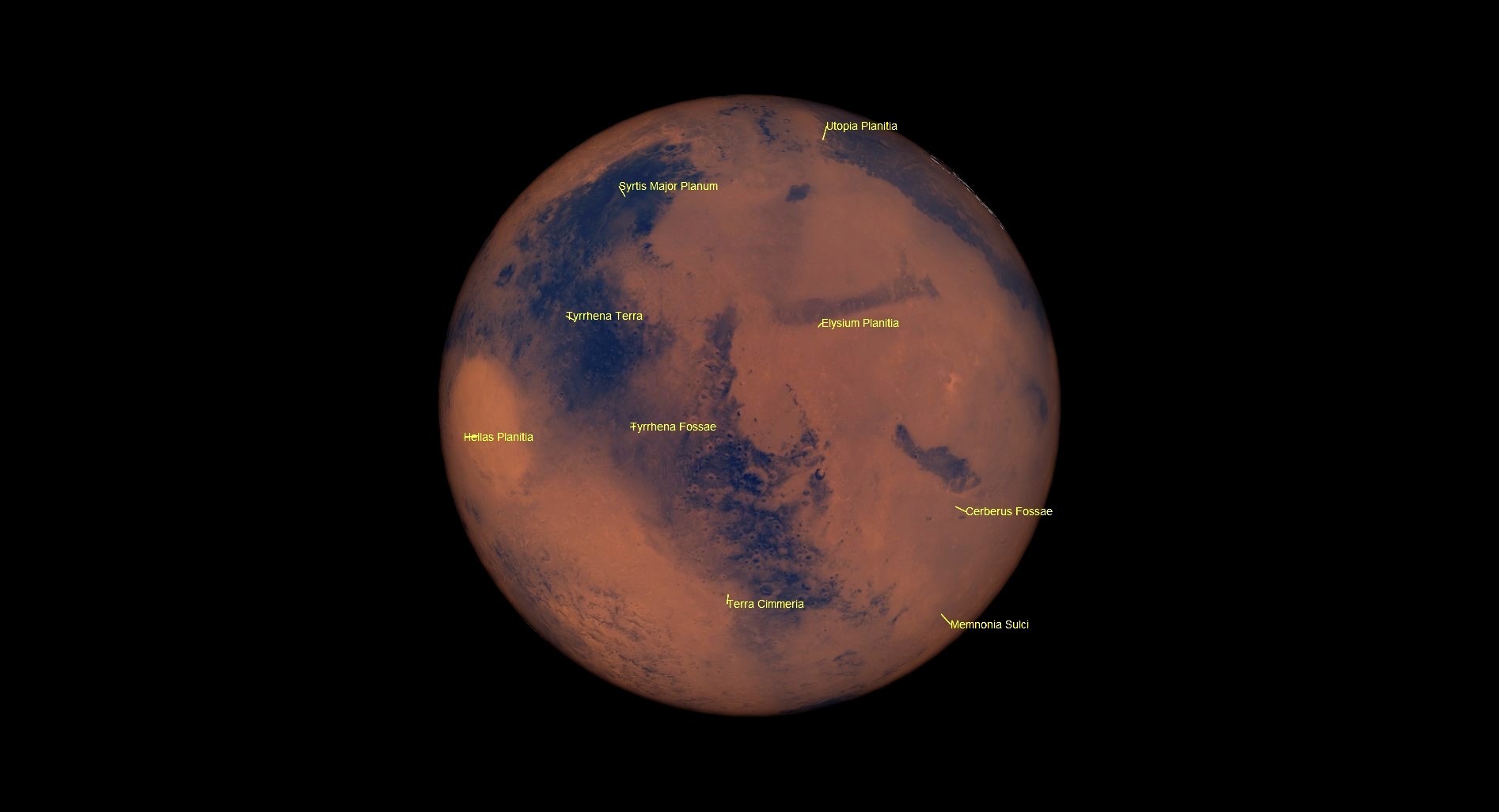
This labelled map of Mars shows which features will be facing Earth-based telescopes around midnight EST on December 7-8, the night of Mars’ opposition. Mars’ northern polar cap will appear as a bright spot that the darge wedge of Syrtis Major points toward. Your telescope will probably mirror image and/or invert this view. (Starry Night Pro)
Hello, December, Stargazers!
Here are your Astronomy Skylights for the week of December 4th, 2022 by Chris Vaughan. Feel free to pass this along to your friends and send me your comments, questions, and suggested topics. You can also follow me on Twitter as @astrogeoguy! Unless otherwise noted, all times are expressed in Eastern Time. To subscribe to these emails please click this MailChimp link.
If you’d like me to bring my Digital Starlab portable inflatable planetarium to your school or other daytime or evening event, or deliver a session online, contact me through AstroGeo.ca, and we’ll tour the Universe, or the Earth’s interior, together! My terrific book with John A. Read entitled 110 Things to See With a Telescope is a guide to viewing the deep sky objects in the Messier List – for both beginners and seasoned astronomers. DM me to order a signed copy!
The bright moon will dominate the night sky worldwide this week, but Mars’ opposition on Dec 7-8 with give it some competition. Not to be outdone, though, the full moon will occult Mars for lucky observers in most of North America and Europe. The rest of the planets are visible after sunset, too. Jupiter will host quite a few shadow transits, and you might even spot a few meteors. Read on for your Skylights!
Meteor Shower Update
Keep an eye on the sky for shooting stars! The terrific Geminids meteor shower will be ramping up to its peak night of December 13-14. During evenings this week, true Geminids will appear to be streaking away from the northeastern sky, where its radiant in the constellation of Gemini (the Twins) will be ascending. Meteors travelling in other directions will be sporadic meteors or leftovers from the Taurids.
The media usually only promotes meteor showers on their peak nights – but Skylights readers know that showers are worth stepping outside for on the surrounding nights. I’d rather see fewer of them on a clear night, than none at all on a cloudy peak night! By the end of this week, lucky observers could be seeing a meteor every minute or two in a clear sky.
The Moon Meets Mars
Earth’s natural night-light will bathe the night sky worldwide with moonlight this week – throwing a wet blanket on stargazing and Geminids meteor-watching. The good news is that the moon looks terrific in binoculars and backyard telescopes. Even the youngest budding astronomers can view it, starting in daylight during late afternoon or in the dark sky before bedtime!
Tonight (Sunday) the moon will rise in the east during mid-afternoon. Look for its ghostly, nearly round form climbing the sky even before the sky begins to darken at sunset. After dusk, the bright gibbous moon will be joined by the bright planets. From left to right (celestial east to west) Mars, the moon, Jupiter, and Saturn will all be separated by about 40°, or four times the width of a clenched fist when held up to the sky with your arm outstretched and one eye closed. Their sky-spanning chain traces out the plane of our solar system. The moon will break that pattern when it hops east for the rest of this week.
Sunday’s moon will shine below the stars of Aries (the Ram). The moon will be positioned less than a fist’s diameter to the right (or approximately 8 degrees to the celestial WSW) of the magnitude 5.6 planet Uranus. The moon’s continuous eastward orbital motion, plus the diurnal rotation of the sky, will shift it closer to Uranus during the night and roll the moon below Uranus after midnight. Observers in westerly time zones of North America will see the pair closest together before dawn. Hours later, observers in northeastern Africa, Europe (except Iceland), part of the Middle East, Russia, and northern Japan can see the moon cross in front of, or occult, Uranus on Monday around 17:00 Greenwich Mean Time. On Monday night, the even fuller, brighter moon, still within the bounds of Aries, will shine to Uranus’ left (celestial east).
From Tuesday to Thursday, the moon will traverse Taurus (the Bull) and give some lucky observers a spectacular sight! Tuesday night’s moon will overwhelm the pretty group of stars known as the Pleiades and the Seven Sisters, which will be positioned several finger widths above it. Tuck the moon just out of sight below your binoculars’ field of view to see those stars. Do you see seven of them – or fewer – or more?
The big event will happen on Wednesday night in the Amercas. When the moon rises around 4 pm local time, it will look full – but it won’t officially reach that phase until later. Once the sky darkens a little, look for the bright red dot of Mars shining a short distance to the moon’s lower left or celestial east. The moon slides east by its own diameter with every passing hour, so as the evening wears on, you’ll see the moon-Mars separation decrease.
Full moons occur when the moon is opposite the sun in the sky. Sometimes it’s precisely opposite and we experience a total lunar eclipse, as we did last month. The rest of the time, the moon rides a few degrees higher or lower than the anti-solar point. The December full moon will occur at 11:08 pm EST or 8:08 pm PST on Wednesday, December 7 in the Americas. (That converts to 04:08 GMT on Thursday, December 8.) Traditionally known as the Oak Moon, Cold Moon, and Long Nights Moon, it always shines in or near the stars of Taurus and Gemini. The Ojibwe of the Great Lakes region call the December full moon Manidoo Giizisoons, the “Little Spirit Moon”. For them it is a time of purification and of healing of all Creation. The Woodland Cree of the Central Canada call the December moon Thithikopiwipisim, the “Hoar Frost Moon”, when frost sticks to leaves and other things outside. Since it’s opposite the sun on this day of the lunar month, the moon is fully illuminated and rises at sunset and sets at sunrise. Full moons during the winter months climb as high in the sky at midnight as the summer noonday sun, and cast similar shadows.
When the moon reaches its full moon sky position at 11:08 pm EST, Mars will be waiting there for it! Since the planet Mars will also be opposite the sun that night, observers in northwestern Mexico, the Continental USA (except for southern and eastern states), all of Canada (except southwestern Nova Scotia), Greenland, Svalbard, western Europe, and the northern coast of Africa can watch the moon pass in front of, or occult, Mars! The event can be observed with unaided eyes, but binoculars and backyard telescopes will make it more thrilling. Exact times of the event vary by location, especially your latitude, so use Stellarium or an app to determine your own circumstances. In the Greater Toronto Area, the leading edge of the moon will cover Mars at 10:29 pm EST on Wednesday evening. Since Mars will be enlarged by its relative proximity to Earth this week, the moon will take more than full minute to cover the planet – giving you plenty of time to share the views in your telescope with friends and family!

Mars will take more than minute again to reappear from behind the moon’s opposite, southern limb – at 11:17 pm EST. In Europe, the occultation will occur before dawn on Thursday morning. Wherever you are, start watching several minutes ahead of each time. If you aren’t sure where Mars will reappear, use a magnification that shows the entire moon, and then swap in a stronger eyepiece once Mars begins to emerge. For those wanting more precision – to capture a close-up video, for example – let your mount track Mars instead of the moon. In the GTA, aim your telescope/camera at the moon’s limb midway between the prominent craters Tycho and Stevinus. That emerging location will be dramatically different for other places on Earth.
By the way, a medium-bright star named Kappa Tauri will be shining just a quarter of a degree (half the moon’s diameter) to the left of Mars that night. It, too, will be occulted by the moon 30 minutes after Mars. Unlike Mars, the star will wink out and re-appear instantly because it’s a point source of light.
For the rest of this week, the moon will wane in phase and rise after sunset. On Friday and Saturday it will cross through Gemini (the Twins), on Saturday night shining several finger widths to the right (or several degrees to the celestial southwest) of the bright star Pollux. Its fainter twin, the star Castor, will shine to their upper left. As the grouping crosses the sky during the night, the eastward orbital motion of the moon will carry it closer to Pollux during the wee hours of Sunday. Meanwhile, the diurnal rotation of the sky will swing the moon to the stars’ left.
The Planets
I already mentioned above that the moon will join the bright planets this week and that Mars will be occulted by the moon when they are both at opposition overnight on Wednesday/Thursday. Here are some more details.
Mars will officially reach opposition at 05:40:34 Greenwich Mean Time on Thursday, December 8. That translates to 12:40 am EST on Thursday morning and 9:40 pm PST on Wednesday evening. On Wednesday night, the bright red planet and the full moon will rise along the northerly horn of Taurus (the Bull) at sunset, climb to their highest positions due south at midnight local time, and then set at sunrise. As I described above, for observers located across most of North America, the full moon will occult Mars on Wednesday evening. (At its moment of opposition the full moon is broad enough to occult Mars, even though that planet will still need two more hours to become 180° from the sun.)
On opposition night, Mars will shine with a peak visual magnitude of -1.97. Mars will be boosted by a phenomenon called the Opposition Surge or Opposition Effect or Seeliger Effect, backscattered sunlight brightening both the planet and its two moons. Although its distance from Earth of 82.15 million km, 0.549 Astronomical Units, or 4.72 light-minutes will be slightly greater than it was at closest approach last week on November 30, Mars will still be an impressive sight in backyard telescopes, showing an apparent disk diameter of 17.05 arc-seconds (Jupiter’s disk spans about 42 arc-seconds and the full moon is 1,800 arc-seconds wide). Mars takes about 20 minutes longer than Earth to rotate once fully on its axis. So viewing the planet at the same time on subsequent nights will show roughly the same view of it, but with the surface markings shifted by about 5°. If you have coloured filters for your telescope, see if the blue, orange, or red one improves the view. If you find Mars is too bright, use a moon filter on it.

Mars’ Earth-facing hemisphere on December 7-8 will display its bright northern polar cap – visible as a small bright spot along the planet’s edge, the dark Tyrrhena Terra, Cimmeria Terra, and Sirenum Terra regions, and the lighter-toned Amazonis Planitia and Eylsium regions. The polar cap might look larger or stretched out along Mars’ edge if you are viewing it through turbulent air or a mis-collimated telescope. After the lunar transit, the very dark, wedge-shaped Syrtis Major Planum region, the dark Tyrrhena Terra, and Sinus Sibaeus regions, and the lighter-toned Hellas Planitia region will all rotate into view. I’ll post some labelled images here, or you can use a terrific Mars mapping tool created by Ade Ashford at http://www.nightskies.net/skyguide/mars/mars.html. Use the drop-down menu to select from two views of Mars, labelled or not.
Mars oppositions occur approximately every 25.6 months. That’s why we send spacecraft to Mars every two years – it’s a shorter trip then! Due to the elliptical shape of the orbits of Earth and Mars, both planets vary their distance from the sun. Mars varies by 20%, Earth by only 3%. Mars oppositions that occur in late summer (around Earth’s aphelion) bring Mars within 55.7 million km or 3 light-minutes of us. Mars is much farther away from Earth during late winter oppositions – 101.4 million km or 5.6 light-minutes. The next Mars opposition will occur on January 16, 2025, so Mars won’t be as close as it is now, making it look smaller in telescopes. The next very close opposition will happen on August 14, 2050, when Mars will show a disk diameter of 25 arc-seconds, or 47% bigger than this one. Mark your calendars!
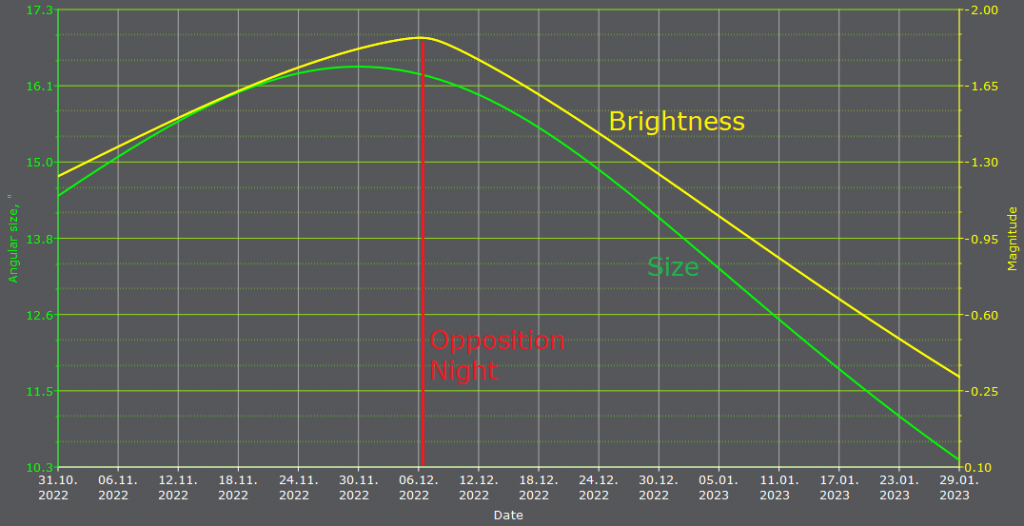
Since last Wednesday, Earth has been slowly increasing our distance from Mars. After this Wednesday, Mars will also begin to fade in brightness. Don’t fret if it’s cloudy on opposition night. Just get a look at your next available opportunity, starting now.
Let’s see what else the planets are up to – starting after sunset.
Mercury and Venus will be lurking just above the southwestern horizon for half an hour after sunset, but only observers in the tropics will see them easily. Only search using your binoculars after the sun has completely disappeared. Those two inner planets will climb a little higher and set a little later with each passing day. Since Mars will already be above the eastern horizon at sunset for mid-northern latitudes, all the planets will be above the horizon. Mars, Jupiter, and Saturn will form a 120 degrees long arc across the sky – tracing out the plane of our solar system. Uranus, Neptune, and a couple of major asteroids will lurk between those bright planets. And the moon will travel between them.
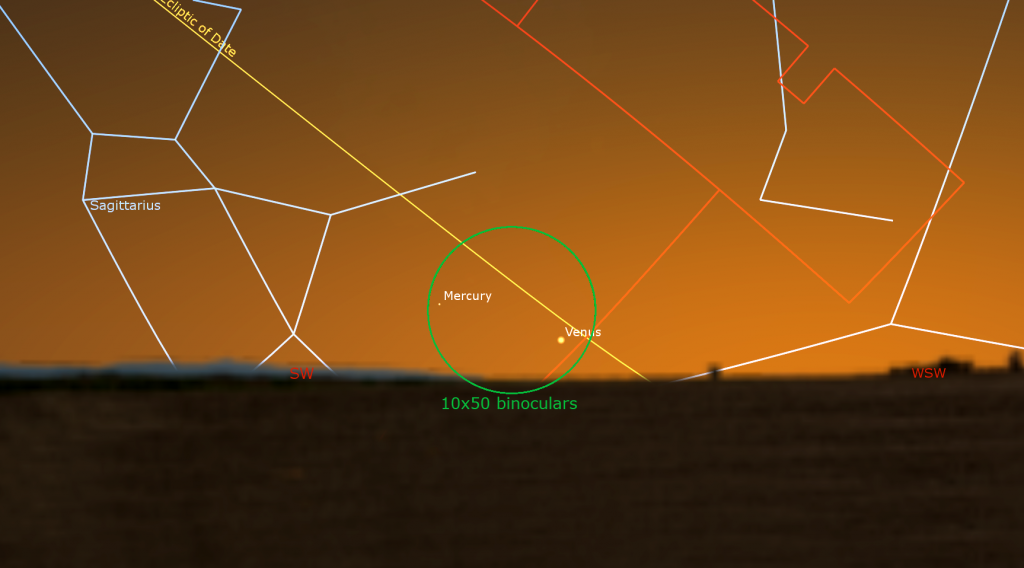
The increasingly earlier sunsets will allow the yellowish dot of Saturn to become visible in the southern sky after 5:30 pm local time. Enjoy your views of it as soon as you can find it in your telescope because it will look less crisp as it drops lower through the evening. Saturn will be shining just to the right (celestial west) of the medium-bright tail stars of Capricornus (the Sea-Goat), Deneb Algedi on the left (celestial east) and Nashira on the right (celestial west). In the coming months, you’ll be able to use binoculars or your sharp eyesight to see that Saturn’s easterly prograde motion is shifting the planet toward them. I plotted Saturn’s long-term path here.
On a night with steady air, quality 10×42 binoculars (and larger) should show Saturn and its rings as a tiny oval. On those nights, even a small telescope can show the planet’s subtly banded globe encircled by its glorious rings, which are sufficiently edge-on to Earth to allow Saturn’s southern polar region to extend well below the ring plane. (Your telescope might flip the planet.) See if you can make out the Cassini Division, a narrow, dark gap that separates Saturn’s main inner ring (named B) from its bright outer ring (named A). Any telescope should show that a segment of Saturn’s rings adjacent to the eastern limb of the planet is in shadow. That wedge will shrink over the coming weeks.
A small telescope can also pick up several of Saturn’s moons – especially its largest, brightest moon, Titan! From here on Earth, Saturn’s axial tilt of 26.7° lets us see the top of its ring plane, and allows its brighter moons to array themselves all around the planet. (In contrast with Saturn, Jupiter’s axis is only tilted by 3°, so Jupiter’s moons are arranged in a line running through that planet’s equator.)
Titan never wanders more than five times the width of Saturn’s rings from the planet. The much fainter moon named Iapetus can stray up to twelve times the rings’ width during its 80-day orbit of Saturn. The next brightest moons Rhea, Dione, Tethys, Enceladus, and Mimas all stay within one ring-width of Saturn. During evening this week, Titan will migrate counter-clockwise around Saturn, moving from the lower right (or celestial west) of Saturn tonight (Sunday) to the upper left (or celestial northeast) of Saturn next Sunday. (Remember that your telescope might flip that view around.) How many of the moons can you see in your telescope?

Extremely bright, magnitude -2.6 planet Jupiter, which will shine 21 times brighter than Saturn, will become visible in the southeast at about 5 pm local time. Nothing else will be close to matching its brilliance until half as bright Mars appears. Jupiter will look best in a telescope when it climbs highest (or culminates) due south around 7:20 pm local time, and then it will set in the west at about 1:20 am.
Your binoculars should be able to show you Jupiter as a small disk bracketed by its line of four Galilean moons named Io, Europa, Ganymede, and Callisto. Those moons complete orbits of the planet every 1.7, 3.6, 7.2, and 16.7 days, respectively. If you see fewer than four moons, then one or more of them is crossing in front of or behind Jupiter, or hiding in Jupiter’s dark shadow – or two of the moons are very close together or occulting one another. The moons’ arrangement varies each night.
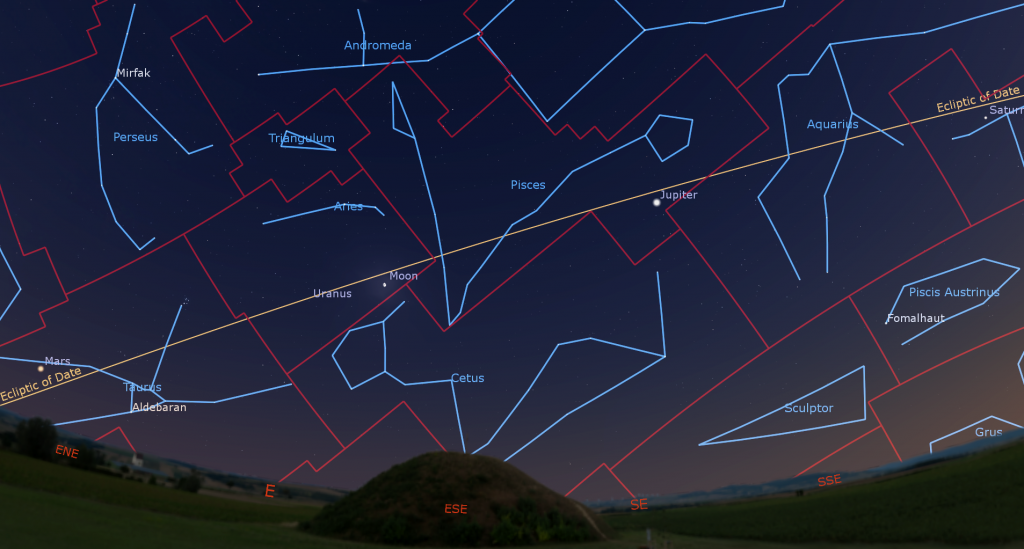
Once the sky is fully dark, use your binoculars to spy a pentagon-shaped ring of low-brightness stars shining about a fist’s diameter to the upper right of Jupiter. They make up the western head of Pisces (the Fishes). Above those stars, the Great Square of Pegasus (the Flying Horse) will be visible, even with your unaided eyes. It’s located about 2.5 fist diameters above Jupiter. The bright moon will make seeing those stars harder this week.
Even a small, but decent quality telescope can show you Jupiter’s dark belts and light bands, which are aligned parallel to its equator. With a better grade of optics, Jupiter’s Great Red Spot, a cyclonic storm that has raged for hundreds of years, becomes visible for several hours when it crosses the planet every 2nd or 3rd night. For observers in the Americas, that GRS will cross Jupiter’s disk in early evening on Monday, Wednesday, and Saturday, and late on Sunday, Friday, and Sunday evening. If you have any coloured filters or nebula filters for your telescope, try enhancing the spot with them.
The round, black shadows of Jupiter’s Galilean moons are visible through a good backyard telescope when they cross the planet’s disk. On Sunday evening, December 4 observers in western North America can watch the small shadow of Europa cross the southern hemisphere of the planet from 5:15 pm to 7:35 pm EST. On Thursday, Ganymede’s large shadow will cross Jupiter’s southern hemisphere from 3:40 pm EST (in twilight) to 6:07 pm EST. For observers in the Mountain and Pacific Time zones, Io’s shadow will cross Jupiter’s equator with the Great Red Spot on Thursday night from 9:38 pm to 11:46 pm MST. On Saturday, Io’s shadow will cross between 6:08 and 8:15 pm EST. Europa’s shadow will cross again on Sunday, December 11 from 7:53 to 10:10 pm EST. Don’t forget to adjust these quoted times into your own time zone.

In mid-evening this week, magnitude 7.9 Neptune will be located a palm’s width to the lower right (or 6° to the celestial west-southwest) of Jupiter, about halfway to the medium-bright star Phi Aquarii. After completing its annual retrograde loop yesterday, Neptune will slowly resume its regular eastward motion through the stars of northeastern Aquarius (the Water-Bearer). Neptune’s apparent disk size is 2.3 arc-seconds (20 times smaller than Jupiter’s). Try to view Neptune while it is highest, around 7 pm. Neptune is binoculars-close to several groups of medium-bright stars. I posted a finder chart for Neptune here. The large asteroids designated (4) Vesta and (3) Juno are currently travelling towards Jupiter through the knee stars of the Water-Bearer.
Mars will be visible all night long both before and after its date with the full moon. Once it clears the rooftops after dusk, its bright, magnitude -1.9 reddish dot can’t help but catch your eye. Mars will be positioned between the bright northern horn star of Taurus (the Bull), Elnath, and the even brighter reddish star Aldebaran, which marks the bull’s eye. Early risers can spot Mars above the western horizon before sunrise. Over the next month, Mars will steadily slide towards the bright Pleiades star cluster, which is the prominent little clump of stars above Aldebaran.
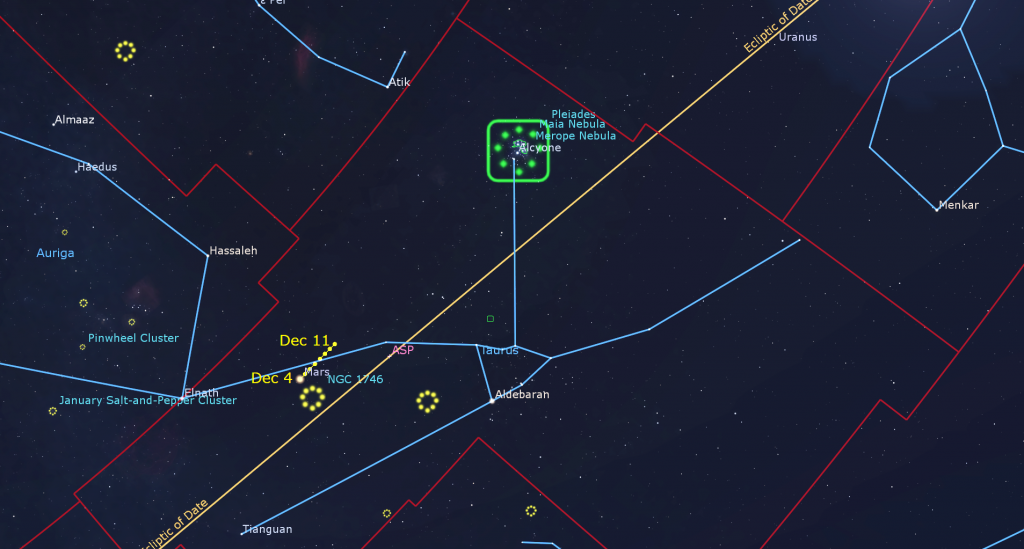
Until Monday, Mars will be positioned just a thumb’s width above (to the celestial north of) a large open star cluster named NGC 1746. That’s close enough for them to share the eyepiece in a backyard telescope at low magnification. NGC 1746’s stars are scattered over an area larger than a full moon. Your telescope will probably flip and/or mirror that arrangement.
The distant blue-green planet Uranus is located about midway between Mars and Jupiter, and about 1.4 fist widths to the upper right (or 14° to the celestial west-southwest) of the Pleiades star cluster. Closer guideposts to Uranus are several medium-bright stars, including Botein (or Delta Arietis), Al Butain II (or Rho Arietis), and Sigma Arietis, which will appear several finger widths from the planet. Those stars mark the feet of the Aries (the Ram). Magnitude 5.6 Uranus will be high enough for telescope-viewing, in the lower part of the eastern sky, before 7 pm local time this week. It will climb to its highest point in the southern sky around 10 pm local time. The bright moon will hop past Uranus this week, as I described above.
Holiday Season Bright Lights
If you missed last week’s story about the brightest stars in the evening sky, I posted it here.
Public Astro-Themed Events
Every Monday evening, York University’s Allan I. Carswell Observatory runs an online star party – broadcasting views from four telescopes/cameras, answering viewer questions, and taking requests! Details are here. They host in-person viewing on the first clear Wednesday night each month. On Wednesdays they stream views online via the observatory YouTube channel. Details are here.
On Wednesday evening, December 7 at 7:30 pm EDT, the RASC Toronto Centre will live stream their monthly Recreational Astronomy Night Meeting at https://www.youtube.com/rasctoronto/live. Talks include The Sky This Month presented by me and a tale of an astronomers’ gathering in Algonquin Park. Details are here.
My free, family-friendly Insider’s Guide to the Galaxy webcast with Samantha Jewett of RASC National returns on Tuesday, December 6 at 3:30 pm EST. This time, the holidays are upon us, so we’ll gather a few friends to chat about the astronomy-related items on our wish lists – books, gear, apparel, and more. We’ll touch on the Dec 7 Mars opposition and lunar occultation, and we’ll highlight the next batch of RASC’s Finest NGC objects. You can find more details and the schedule of future sessions here.
Keep looking up, and enjoy the sky when you do. I love questions and requests. Send me some!